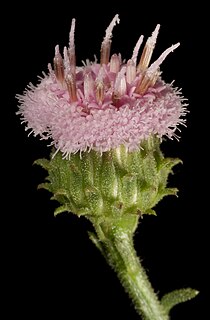
Zygophyllaceae is a family of flowering plants that contains the bean-caper and caltrop. The family includes around 285 species in 22 genera.

Tribulus is a genus of plants in the family Zygophyllaceae and found in diverse climates and soils worldwide from latitudes 35°S to 47°N. The best-known member is T. terrestris, a widespread invasive species and weed.

Banksia baueri, commonly known as the woolly banksia, is a species of shrub that is endemic to the southwest of Western Australia. It has serrated leaves and a distinctively large and hairy looking inflorescence with cream, yellow or brown flowers, and hairy fruit.

Banksia elegans, commonly known as the elegant banksia, is a species of woody shrub that is endemic to a relatively small area of Western Australia. Reaching 4 m (13 ft) high, it is a suckering shrub that rarely reproduces by seed. The round to oval yellow flower spikes appear in spring and summer. Swiss botanist Carl Meissner described Banksia elegans in 1856. It is most closely related to the three species in the subgenus Isostylis.

Banksia splendida, commonly known as shaggy dryandra, is a species of shrub that is endemic to the southwest of Western Australia. It has sharply-pointed linear leaves that are woolly on the lower surface, cream-coloured and maroon or yellow flowers in heads of between 65 and 115, and later up to eight egg-shaped follicles in each head.

Banksia sessilis var. cordata is a variety of Banksia sessilis, with unusually large leaves and flower heads. It is a rare variety that is restricted to the extreme south-west corner of Western Australia.

Persoonia falcata, commonly known as the wild pear, is a shrub native to northern Australia.

Corymbia grandifolia, commonly known as the cabbage gum, large-leaved cabbage gum and the paper-fruited bloodwood, is a species of tree that is endemic to northern Australia. It has smooth bark, egg-shaped to broadly elliptic to lance-shaped adult leaves, flowers buds in groups of three or seven, creamy white flowers and cup-shaped to cylindrical fruit.

Scaevola canescens is a species of plant in the family Goodeniaceae. It is endemic to Western Australia where it occurs "from Shark Bay to Perth, in open forest and heath in sandy soil".

Bossiaea bossiaeoides is a glaucous shrub from 0.5 to 2 m high, in the pea family (Fabaceae), which is found in northern Australia, in the Northern Territory, Queensland and Western Australia. Apparently leafless, it has branches which are broadly winged. It grows on sand and sandstone, on stony hillsides, creek banks and outcrops. Its flowers are yellow and it flowers from April to August.

Calandrinia corrigioloides is an annual herb in the family Montiaceae, and is native to Western Australia, South Australia, and Victoria.

Calandrinia granulifera is an annual herb in the family Montiaceae, and is native to New South Wales, Tasmania, Western Australia, South Australia, and Victoria.

Atriplex stipitata, known as mallee saltbush and kidney saltbush, is a species of shrub in the family Amaranthaceae, found in all mainland states of Australia.

Boronia wilsonii is an erect shrub that is endemic to northern Australia. Its branches, leaves and backs of the flowers are densely covered with woolly hairs. The petals are white to pink or burgundy-coloured.

Tribulus platypterus, the cork hopbush, is a species of flowering plant in the family Zygophyllaceae, which is endemic to the northwest of Western Australia. It is closely related to Tribulus suberosus.

Harpullia leichhardtii is a tree in the family Sapindaceae, endemic to the Northern Territory.

Dampiera candicans is a plant in the family Goodeniaceae, native to Western Australia and the Northern Territory.

Podolepis aristata is a herb in the Asteraceae family, which is found in Western Australia, and all mainland states and territories of Australia.

Tribulus occidentalis, common name perennial caltrop, is a species of flowering plant in the family Zygophyllaceae, which is native to Australia, and found in Western Australia, Queensland, South Australia and the Northern Territory.

Pluchea dentex is a plant in the Asteraceae family, first described in 1867 by George Bentham, from specimens collected in Queensland by Robert Brown at Broad Sound and Thirsty Sound, by Ferdinand von Mueller at the source of the Gilbert River, and one by Eugene Fitzalan at Port Denison.




















